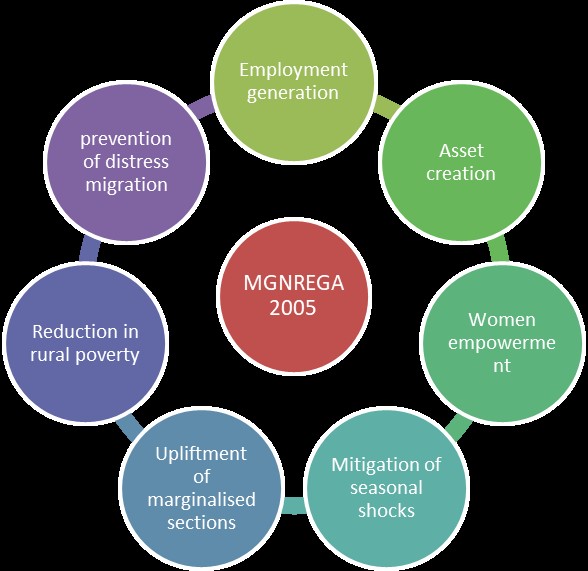Centre Caps MGNREGS Spending, Triggers Legal Concerns in Indian Politics
Centre Caps MGNREGS Spending, Triggers Legal Concerns in Indian Politics
Why in the News?
The Finance Ministry has imposed a spending cap on MGNREGS for the first half of FY 2025–26, citing budgetary concerns. This move, occurring against the backdrop of Indian politics and ongoing debates about social justice, has sparked criticism. Opponents argue that this decision violates statutory employment rights and fails to accommodate rural distress and fluctuating demand, raising questions about its impact on the Indian caste system and the broader social reality in India. The decision has implications for caste in Indian society, potentially affecting various socio-economic groups differently, including the middle class and lower OBCs, as well as ethnoreligious groups.
Rationale Behind the Spending Cap:
- The Finance Ministry has limited MGNREGS spending to 60% of the annual budget (₹86,000 crore) for the first half of FY 2025–26.
- This cap aims to prevent early exhaustion of funds, which previously left large dues unpaid by year-end, a situation that has implications for welfare programmes and could exacerbate the effects of economic slowdown.
- In past years, 70% of the budget was exhausted by September, forcing supplementary allocations in December that often ran out by January.
- Pending dues over the last five financial years have ranged from ₹15,000 crore to ₹25,000 crore.
- The move seeks to ensure funds for the second half without needing extra allocations, reflecting a shift in approach to evidence-based policymaking. This decision has been supported by the BJP government, which has faced criticism from opposition parties, including Congress, regarding its handling of rural employment schemes. The BJP’s stance on MGNREGS spending aligns with its broader Hindutva ideology, which emphasizes self-reliance and economic development.
Issues with Demand and Rural Realities
- MGNREGS is demand-driven, providing a statutory right to work during periods of rural stress, which is closely tied to Indian caste system inequalities and the broader social reality of India.
- Work demand fluctuates—high in April-June, surges again after Kharif sowing.
- Unpredictable weather (e.g., drought in Karnataka in 2023) often leads to spikes in demand, which the cap fails to accommodate.
- States may overspend early due to climate distress, leading to fund shortages later, potentially exacerbating issues related to caste sociology and the digital divide impact in rural areas.
- The cap could hinder political mobilization efforts among rural communities, particularly affecting lower socio-economic groups who rely heavily on MGNREGS for employment, while potentially widening the north-south divide in terms of resource allocation and state representation.
Legal and Implementation Concerns
- MGNREGS is backed by the MGNREGA Act, 2005, giving citizens a legal right to employment, which is fundamental to addressing caste inequalities and promoting social justice.
- Capping expenditure can undermine this right if funds run out, despite demand, raising concerns about policy implications and the effectiveness of welfare programmes.
- The lack of clarity on what happens post-cap raises fears of job denials and wage delays, which could disproportionately affect Scheduled Castes and Scheduled Tribes, as well as lower OBCs and various ethnoreligious groups.
- Supreme Court rulings (e.g., Swaraj Abhiyan v. Union of India) affirm that financial constraints can’t override statutory duties, emphasizing the need for evidence-based policymaking in addressing social realities.
- Civil society warns this move violates constitutional principles of livelihood protection under Article 21, highlighting the ongoing challenges in Indian politics and the need for comprehensive social justice measures.
- The situation underscores the importance of accurate OBC data and the potential role of a new Socio-Economic and Caste Census (SECC) in informing policy decisions related to welfare schemes like MGNREGS. The last comprehensive caste data collection occurred during the 1931 census, making the upcoming SECC crucial for understanding current social dynamics.
Key Features and Impact of MGNREGA (2005) : |
|
● Employment Guarantee: Provides 100 days of wage employment annually to rural households. |
|
● Funding Pattern: Follows a 90:10 Centre-State cost-sharing ratio. |
|
● Legal Entitlement: Guarantees employment; compensation paid if work isn’t provided within 15 days. |
|
● Timely Wage Payment: Wages must be paid within 15 days of work completion. |
|
● Worksite Facilities: Must include drinking water, shade, and first aid. |
|
● Asset Creation: Focus on durable rural infrastructure like roads, irrigation, and water conservation. |
|
● Social Inclusion: Prioritizes women, SCs, and STs, addressing aspects of caste sociology. |
|
● Women’s Participation: Increased from 48% to over 58% (FY14–FY25). |
|
● Decentralized Planning: Strengthens PRIs’ role. |
|
● Nationwide Reach: Covers all rural districts; 8.07 crore assets created, contributing to welfare programmes and addressing economic slowdown impacts. |
This situation underscores the complex interplay between Indian politics, social justice, and economic policies. The government’s approach to MGNREGS spending reflects broader debates about caste-based enumeration, reservation demands, and the challenges of implementing welfare programmes in a diverse society. As India grapples with these issues, the need for evidence-based policymaking and a nuanced understanding of social realities becomes increasingly apparent.
The ongoing discussions surrounding MGNREGS and its implementation are likely to play a significant role in electoral politics, especially as the country approaches Census 2026-27. When is the census conducted becomes a crucial question, as the upcoming census may provide vital data on demographic shifts and socio-economic conditions, potentially influencing future policy decisions on rural employment schemes and caste-based welfare measures. The reference date and census definition will be critical in capturing an accurate snapshot of India’s diverse population, including the list of castes in India and their representation in various socio-economic strata.
The BJP government’s stance on MGNREGS and its impact on different caste groups, including upper castes and lower OBCs, could have significant implications for Lok Sabha seats in future elections. The potential redistribution of resources and political power may further accentuate the north-south divide, making the upcoming Socio-Economic and Caste Census (SECC) a crucial tool for policymakers and political parties alike. The SECC’s importance is underscored by the fact that the 2011 census did not include comprehensive caste data, leaving a significant gap in our understanding of India’s social landscape.
As India prepares for the next census, issues of census participation and caste data collection have come to the forefront. The inclusion of language data in census questionnaires adds another layer of complexity to the process, reflecting India’s linguistic diversity. The population count and delimitation processes that follow the census will have far-reaching consequences for political representation and resource allocation.
It’s important to note that the census and subsequent policy decisions must be conducted with sensitivity to avoid exacerbating existing social tensions. Concerns about anti-Muslim prejudice and the marginalization of other minority groups must be addressed to ensure a fair and inclusive process. The legacy of the Mandal upsurge, which followed the implementation of recommendations from the Mandal Commission report based on the 1931 census data, serves as a reminder of the potential for caste-based policies to reshape India’s political landscape.
In conclusion, the MGNREGS spending cap and the broader issues it raises highlight the need for a comprehensive, data-driven approach to social welfare and economic policy in India. The upcoming census and SECC will play crucial roles in shaping these policies, making it essential for all stakeholders to engage in constructive dialogue and ensure that the process accurately reflects India’s complex social reality.






